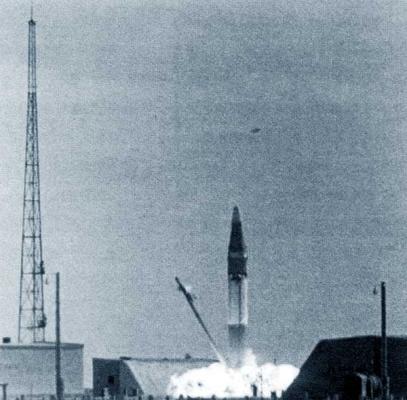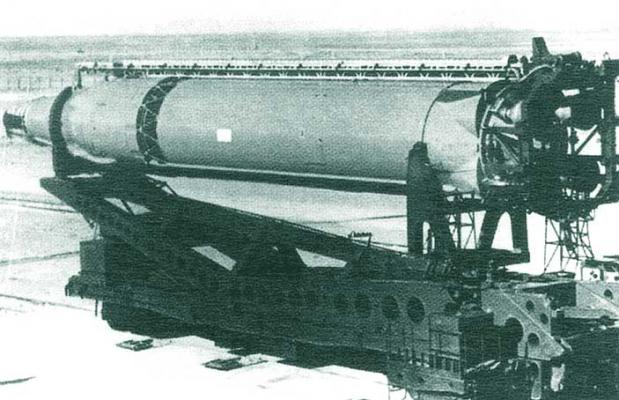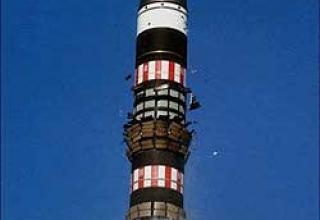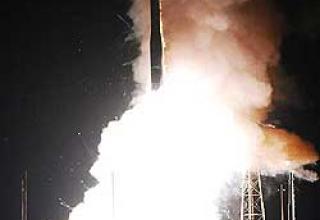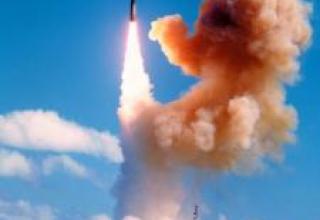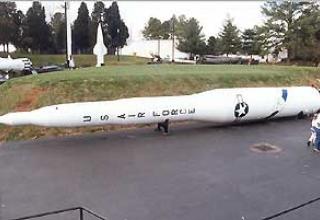Based on the progress made by the beginning of 1958 in creating more economical engines and head units with a much lower mass of nuclear charge, the Council of Main Structures sent in April 1958 to the Government of the USSR a proposal to develop a new intercontinental ballistic missile R-9 on the rocket fuel "oxygen-kerosene" with an initial mass of about 100 tons. S.P. Korolev made great efforts to persuade the Council of Chiefs to sign these proposals. V.P. Barmin and N.A. Pilyugin strongly doubted the reality of the declared launch weight (for example, R-16 was 30 tons heavier), V.P. Glushko initially did not agree to the development of an oxygen engine with a thrust of 140 tons and insisted on the use of high boiling fuel components. When information was received in 1958 that the Americans in the latest Titan I ICBM, as well as in Atlas ICBM, use liquid oxygen as an oxidizer, this at first glance confirmed the correct choice of oxygen, not high boiling components. The Titan I missile was based in a FPU and was ready to launch after refuelling for 15 minutes. This was not yet available to any of the Soviet missiles. However, at the end of 1961 it was reported that the latest Titan II ICBMs with high boiling components, placed in fueled single-screw ICBMs, could launch 1.5-2 minutes after receiving the command. At the same time, data was received on the planned decommissioning of Titan I and Atlas missiles. Now there were supporters of V.P. Glushko and high boiling MRTs on the "horse". Since at that time it was not quite clear which of the pairs of components would provide better operational conditions for the troops and shorter launch preparation time, after additional studies, OKB-1 proposed to develop two versions of the missile differing in the used fuel components and propulsion systems: R-9A (on low-boiling components of "kerosine-liquid oxygen" fuel) and R-9B (on high-boiling components of "kerosine-nitric acid" fuel). Everything was determined by the complexity of the systems for maintaining the fuel components in readiness for refueling, the toxicity of the components, the time required for refueling the rocket, and the time for unwinding gyro devices before launch. Given that the launch readiness times of both system options are approximately the same and that operational performance, including missile safety, is preferable to kerosene oxygen components, OKB-1 insisted on taking the R-9A missile for further development.
The missile, as a combat weapon, requires the maximum possible time to stand by and the minimum time to prepare for launch. These tasks are made easier when the missile is stored for a long time in a fueled state, but for an oxygen missile this was almost impossible. It was necessary to ensure that the time of refueling of the R-9A missile did not exceed the total preparation time of the missile. Thus, the necessity of storing the missile for a long time in the fueled state was ruled out. The Decree of the Government of the USSR on the development of the R-9A missile on May 30, 1960 specifically noted that as an oxidizer should be used subcooled oxygen. V.P. Mishin was the first to express the idea of using subcooled liquid oxygen. If instead of minus 183 ° C close to the point of boiling oxygen, reduce its temperature to minus 200-210 ° C, then, firstly, it will take a smaller volume, secondly, drastically reduce the losses on evaporation, and thirdly, it will be possible to carry out high-speed refueling (oxygen, getting into a warm tank, will not boil as usual). This will make it possible to store oxygen in a ground tank and refuel it into the rocket almost without losses in the time it takes to prepare the control system instruments for launch. It allowed to provide storage of oxygen in the ground container and its filling into the rocket practically without losses for the time not exceeding the time of preparation of control system devices to launch (the main "limit" was the time of gyro devices preparation). The chosen solution was absolutely correct, and its correctness was confirmed by time - in the future, the Soviet missiles (including the "lunar tsar-rocket" H-1/11A52 and universal heavy booster "Energia"/11K25) used subcooled fuel components. The duration of stay of the rocket R-9A in the fueled state was 24 hours, but the missile could stand on duty without fuel components. All systems and units of R-9A rocket could ensure its stay in readiness № 1 for 1 year under the condition of periodic (without taking off the start) routine maintenance.
During the conceptual design five basic schemes of the rocket providing the required characteristics with the maximum possible simplicity, mobility and the minimum possible mass of construction were considered. This was achieved by adopting a number of design and layout solutions, for example, the use of open enzyme compartments for joining the rocket stages, the dumped tail compartment of the II stage, the use of vapors from the inflated tank of the fuel tank of the II stage to separate the GC, etc. The dimensions of the rocket were chosen from the possibility of its transportation in assembled form in one railway car and the use of welding and stamping equipment of the R-7 rocket for the production of blocks of the R-9A rocket.
The development of the R-9A missile began at OKB-1 under the leadership of C. The Queen after the release of the Decree of the Government of May 30, 1960 and the order of the USSR State Committee for Defense Equipment of November 22, 1961. Design and development of the R-9A missile control system was carried out at NIIAP under the leadership of Chief Designer N.A. Pilyugin. The command instruments were developed under the leadership of V.I. Kuznetsov at NII-944, and the radio control system was developed at NII-885 under the leadership of M.S. Ryazansky. V.P. Barmin (State Design Bureau "Spetsmash") was appointed as the Chief Designer for the ground complex. The I-stage engine was developed at the design bureau of V.P. Glushko, and the II-stage engine was developed at the design bureau of S.A. Kosberg. The combat vehicle was developed at KB-11 (Arzamas-16) under the leadership of S.G. Kocharyants. The conceptual design of the R-9A missile was completed back in October 1959, it provided for the possibility of further improvement of the missile characteristics. For this purpose, new NK-9 engines (N.D. Kuznetsova Design Bureau) were developed for the 1st stage (with improved characteristics due to the use of a closed circuit) and for the 2nd stage - an engine based on the "L-block" engine for the Lightning boosters being created in Design Bureau-1. When using new engines and maintaining the launch weight of the rocket maximum range could be increased by 2700 km. While maintaining the given range and mass of the MS, the mass of the missile was reduced by 13 tons. The missile received the index R-9M. However, the Design Bureau N.D. Kuznetsova was unable to organize work on the new engine in time, and V.P. Glushko soon achieved the decision to leave the engine he was developing for the R-9A as the only option for the 1st stage. It should be noted that the contradictions that arose during the creation of the R-9A ICBM between S.P. Korolev and V.P. Glushko in their views on the further use of high and low boiling fuel components led to an open split between them, which became one of the most important (but not the only) reasons for the failure of the Soviet "lunar program" - the Design Bureau N. V. Glushko. D. Kuznetsova, who did not have enough experience, was unable at that stage to create sufficiently reliable and simultaneously powerful oxygen-kerosene boosters for H-1 boosters. V.P. Glushko insisted that the use of liquid propellant on the super-heavy carrier H-1 on high boiling fuel components should be abandoned for environmental reasons - in case of unsuccessful launch (and all 4 attempts to launch H-1 failed) the territory of the range risked to turn into a lifeless desert for a long time. Later, V.P. Glushko himself changed his views - he headed the Central Committee of the Central Committee for Ecological, Technological and Atomic Energy (CCEEM) in 1974 - the former "firm of S.P. Queen" - and the most powerful super-heavy rocket "Energy" created under his leadership was used only for liquid propellant with oxidizer "oxygen" on both marching steps and combustible "kerosene" (1st stage) and "hydrogen" (2nd stage).
Two types of launch complexes were planned for R-9A ICBMs: ground-based - Desna-N and mine - Desna-B. In parallel with the design of the missile continued research and development work on the problem of obtaining, transporting and storing subcooled liquid oxygen and reducing its losses. The problem turned out to be so serious that Academician P.L. Kapitsa, a well-known expert in ultra-low temperature physics, was involved as an advisor. Due to application of fundamentally new types of insulation of liquid oxygen tanks (powder, screen-vacuum insulation, etc.) and selection of optimal design of rocket tanks and oxygen storage tanks, new structural materials, implementation of subcooling, it was possible to reduce losses of oxygen from evaporation from 15% at the initial stage of work to 0.05-0.2% (i.e. 75-300 times) before the launch of the rocket for flight tests. In order to ensure the prolonged storage of the rocket in a filled state, the possibility of installing screen-vacuum insulation on oxygen tanks (rocket index 8K77) was studied. It was proposed to use the engines of the R-9M missile variant as engines. The use of these high-energy engines made it possible to equip the missile with a heavier and correspondingly more powerful MS while maintaining the working stock of fuel. But this variant of development has not received, in connection with the big complications at manufacturing of a protective cover (steel with thickness of 0,5 mm) for screen-vacuum thermal insulation (difficulties with welding and its fastening). To maintain vacuum in large volumes, special pumps were required. The Soviet industry did not produce them at that time. S.P. Korolev achieved the decision of MIC to organize the production of such pumps on the model of "Philips". Of course, the firm did not know anything about it. A special gas refrigeration machine was created, which, being installed on a liquid oxygen tank, condensed the oxygen evaporated from the tank and returned it back in liquid state. Replacing the existing types of insulation (mypores, slags) with powders (aerosol, perlite, etc.), which filled the space between the tank and the outer casing, and vacuuming this space turned the oxygen storage tank into a large thermos and dramatically reduced the heat flow to the oxygen tank, and, consequently, its losses from heating and evaporation. This similarity was further enhanced by the use of EVTI, which was mats of shiny thin foil sheets (about 100 pieces) separated from each other by a rare glass fabric. The shiny surface of the foil sharply reduced the transfer of heat to the oxygen tank, and the vacuum in the insulating space of the tank completed the job. To create a vacuum system at numerous oxygen storage facilities, a special forvacuum pump was designed and built in combination with two adsorption pumps using a new synthetic material - zeolite, pre-cooled with liquid oxygen or nitrogen. This design allowed bringing the vacuum from 5x10-2 mm Hg to 1x10-3-1x10-4. It also required mastering of a new welding technology to obtain full tightness of multi-meter welds of storage tanks, to create methods and equipment for quality control. All measures described above minimized the evaporation of the cryofluid. So for the first time in domestic practice the problem of liquid oxygen storage was solved practically without losses. At the same time, studies have shown that there are additional opportunities to improve the efficiency of subcooled liquid oxygen. At minus 203-210°C its fluidity increases greatly. This allowed to sharply reduce the time of refueling (from 25-30 to 3-8 minutes), and instead of pumps it was possible to use compressed air, which squeezed oxygen from the storage tank into the tanks of the rocket with the flow rate up to 700 tons / h. A mobile unit was used for subcooling liquid oxygen, which used the principle of ejection and removal of vapors from the liquid oxygen surface due to the pressure drop in the ejector. In the report notes to the Minister of General Machine Building D.F. Ustinov and Deputy Chairman of the State Planning Committee of the USSR V.M. Ryabikov in May 1961, S.P. Korolev outlined the main results of work on the oxygen theme. Thus, it can be noted that the work on the R-9A rocket allowed to seriously expand the front of work on the cryogenic subject in our country as a whole and to achieve serious results. The obtained results demanded a radical reorganization of the processes of receiving, storing, transporting and filling of cryofluids. The industrial base was fundamentally rebuilt, later the corresponding Decree of the Government of the USSR was issued, in 1972 the largest Union scientific-industrial organization on this problem was created - NPO "Cryogenmash" (Balashikha, Moscow region), which united scientific and production teams.
The main feature of the missile was the inclusion of a transition frame of the launch table. Due to this, the scope of work at the launch was sharply reduced, as all ground-to-board connections were now made at the technical position, after docking to the transition frame missile, and at the launch there were significantly fewer ground-to-board connections. Another peculiarity of the R-9A rocket complex was the system solution of problems related to the long-term storage of liquid oxygen. The system of subcooling, long-term storage and high-speed filling of the rocket with subcooled liquid oxygen was created and the problem of its long-term storage without losses was solved. However, at the LKI stage the shortcomings of the ground-based Desna-N launch complex were revealed. In particular, disadvantages of the layout and design of individual components of the launch table and transition frame were revealed. The transition frame turned out to be very cumbersome and heavy, its mass reached 4.5 t and made up 50% of the dry rocket mass. The technological cycle of launch preparation was insufficiently automated, which lengthened the process of preparation for launch and required a qualified combat calculation. The process of mounting the missile on the launch table proved to be complicated and time-consuming, the filling with fuel components was not fast enough, the launch preparation time was almost 2 hours. All this led to the fact that the Desna-N launch complex was not recommended for service.
In May 1962, it was decided that a better launch pad was needed. It should be noted that the "Desna-N" complex was rejected not because of gross design flaws - the high combat and operational characteristics of the R-9A missile, confirmed by the LKI, required the creation of an even more advanced launch complex with a higher combat readiness, ie it was necessary to approach the missile and the launch complex as a whole. OKB-1 became the lead organization and the main ideologist for the creation of a new ground equipment complex for the R-9A missile. A new transition frame was developed and manufactured, with a mass 3 times smaller than the previous one. The Central Design Bureau of Transport Engineering created an effective device, controlled by one operator, capable of mounting the missile on the launch table in 30 seconds. On the basis of the latest achievements in cryogenic technology was created a system of subcooling, long-term storage without loss and high-speed filling of the rocket with subcooled liquid oxygen, developed (in the State Design Bureau "Spetsmash") a system of high-speed fuel charging (kerosene T-1) with a pumping fuel supply. For the first time at the Krasnaya Zarya plant, an automated rocket launch preparation system (ARS) was created and manufactured at OKB-1, and the classical solutions adopted there were later used for a number of new launch vehicles. The APS was a single automatic system covering the entire complex of automatic control systems for individual units and systems of the launch complex. The APS also controlled semi-automatic draining of fuel components from rocket tanks in the event of a failed launch, removal of the rocket from the boosters. The units and systems of the APS were controlled automatically or, if necessary, manually from the central preparation desk. It was possible to bring the R-9A readiness time for launch, counting from the horizontal position, up to 20 minutes. The new launch complex was named "Valley". Further reduction of the launch readiness time was limited by the time of gyro devices deployment (up to 60000 rpm). This process took 15 min. For the R-9A rocket it was necessary to create also a mine version of the launch complex. There was no experience in creating such a complex either at home or abroad. In the U.S., for Atlas F and Titan I missiles of the same class it was provided only for storage of the missile in a mine - to launch it was lifted to the surface of the Earth. They were afraid to launch the missile from the silo, as the preparation and launch of the engines were associated with the evaporation of liquid oxygen and, consequently, with the mine being contaminated with oxygen, which could cause an explosion. It took time for research and experimentation. However, the situation required an accelerated construction of protected launch pads. It was decided to conduct research and experiments simultaneously with the design and construction of an experimental mine launch pad at Baikonur. Its main developer was the Spetsmash State Design Bureau (Chief Designer V.P. Barmin).
In order to start testing as soon as possible it was decided to build a temporary launch position 300 m away from the R-7 missile's launch pad (pad 1). Temporary launch position R-9A was assigned number 71. This made it possible to use the existing assembly and test building (MEC), filling, ground, power equipment, communications and other facilities of the first site. Flight tests of the R-9A began on April 9, 1961 with a failure. The 2nd stage engine failed at the 155th flight section. The launch can be considered partially successful - in flight the first stage, its engine, control system, central drive, the second stage engine launch, hot separation, the second stage tail compartment reset. The reasons for the subsequent shutdown of the rocket's Stage 2 engine were established on the same day. A valve was found among the wreckage that caused the gas supply to the TNA to stop and the reason for its failure was determined. The valves for subsequent launches were urgently modified. The second start-up on April 21, 1961 from site No.71 was a success - GC reached Kamchatka (Kura test site). On April 25 the third launch was carried out. After 3.85 sec. one of the four chambers sharply went "to the stop", then the pressure in it fell, the rocket began to settle and fell at the very start, a fire started. The cause of the accident was soon determined to be the destruction of the combustion chamber, probably due to high-frequency pressure fluctuations. During 1961, 15 missiles were tested. The last launch from the 71st site took place on August 3, 1961, this time the R-9A only rose and after 0.3 seconds. "sat down" to launch and burned down. The second stage of the LKI was held from March to November 1962, 14 launches were made. Nine of them were considered successful. Most of the emergency launches of the R-9A belonged to the propulsion systems (in flight there were high-frequency oscillations, which led to the destruction of the engines) and control system devices.
The works at the Baikonur site to create the "Dolina" complex were going on at an unprecedented pace - in May 1962 it was decided to modernize the "Desna-N" complex, and at the end of September at site number 75 the construction and installation of a new starter complex "Dolina" was completed. On February 22, 1963, the first rocket launch from this launch complex was successfully carried out. Observers at that time were struck by the fact that automation provided almost complete absence of combat calculations. Self-propelled cart with the rocket, coming out of the assembly and test case and reaching the supports on the launcher, connected to the lifting device, which raised it to a vertical position, automatically docked all communications and fixed the rocket on the launch table. This was followed by high-speed refueling with rocket propellant components, preparation of the control system and aiming. Everything took 20 minutes instead of 2 hours at the "Desna-N" complex. Mine Launch Complex "Desna-B" for R-9 missile was built at the site number 70, it checked all the calculated data and the very possibility of launching a rocket filled with oxygen and kerosene from the mine. During the launch from the mine, the assembly and operation documentation, the technology of building mine launch units, etc. were worked out. On September 27, 1963 the first missile was launched from the mine. It was a success. Alas, however, there were no casualties during testing of the rocket - on October 24, 1963 in the SHPU of R-9A rocket at Baikonur range there was a major fire, 8 people died (in the history of the range October 24 in general became a "black date" - October 24, 1960 in preparation for testing of R-16 rocket there was an explosion and fire, which immediately killed 74 people, more than a dozen people died a little later from injuries). For the final decision on the possibility of adopting the R-9 in service was appointed the third stage of the LKI - the so-called "joint LKI", bearing in mind that the main work was carried out by the staff military calculations, and representatives of industry performed mainly the role of observers. From February 11, 1963 to February 2, 1964, 25 missiles were launched, 17 of them reached their targets. During 3 years 54 missiles were spent on three stages of LKI. After the completion of flight and design tests R-9A missile with a silo ("Desna-B") and ground ("Valley") launch complexes was adopted for service of the Strategic Missile Forces July 21, 1965. Its serial production in 1963 was transferred to the Kuibyshev plant "Progress". The experience gained during the launches and continuous improvement of the culture of serial production at the plant "Progress" did their job - during the control shooting of serial missiles in the period from May 15, 1964 to December 16, 1968 of 16 missiles 14 reached their destination.
December 14 and 15, 1964, respectively, began to put on combat duty the first four missile regiments with ground-based launches, two each near Kozelsk (28th Guards Red Banner Missile Division) and at the Plesetsk test site, and December 26 - the first missile regiment with a conventional control system near Kozelsk. DBKs with R-9A missiles were on combat duty for more than 10 years and were highly appreciated by the troops. However, by the time R-9A was on combat duty, it did not fully meet the requirements for the latest strategic missiles of that time. It was one of the first generation ICBMs and, outperforming American Titan I and Atlas F class ICBMs in terms of combat, technical and performance characteristics (by the time the R-9A began to be on alert they had already been decommissioned, all American first-generation ICBMs were fully decommissioned by the end of June 1965. ) and domestic R-7A and R-16U missiles, it was inferior to the latest U.S. Titan II and Minuteman IA/IB/II ICBMs in survivability, firing accuracy and launch preparation time. In addition, the missile systems with the R-9A proved quite expensive to operate, which could not but affect the scale of their deployment (a total of 27 units were put on combat duty at Kozelskoye, Omsk (20th missile division) and Tyumen (22nd missile division), as well as at the Plesetsk and Baikonur ranges). The R-9A was the last combat missile in the group of the Strategic Missile Forces to use oxygen-kerosene fuel. It was decommissioned from the ranks of the Strategic Missile Forces in 1977.
In the West, the 8K75 (R-9A) missile was designated SS-8 "Sasin".
Composition:
R-9A (see diagram) was a two-stage rocket with sequential stage separation. The 1st stage consisted of an open lattice farm, an oxidizer tank, an instrument compartment, a fuel tank and a tail compartment. On the 1st step there was a four-chamber marching ZHRD RD-111 (8D716) with oscillating combustion chambers, developing a draught of 141 t and developed under the direction of V.P.Glushko. Control of the engine chambers of the 1st stage was carried out by the first developed central hydraulic drive using kerosene after the engine TNA as a working fluid. Each of the four chambers deviated by ±6 degrees from the neutral position, thus controlling the rocket flight. The engine is a further development of the RD-107 engine of the R-7 missile. The pressure in the chambers as compared to RD-107 has increased to 80 atm. (by 20 atm.). Thanks to this, the RD-111 engine was very compact with a thrust 75% higher than the RD-107. However, high pressure was one of the reasons for high-frequency vibrations that led to frequent accidents at the testing stage. In contrast to RD-107, hydrogen peroxide was not required for the TNA drive. Turbogas was produced in the gas generator by burning a small part of the fuel. Primary promotion of the TTA was made by a powder starter. The 2nd stage consisted of conical and cylindrical parts. The conical part of the body consisted of an adapter, fuel tank and oxidizer tank with inter-tank shell. The cylindrical part formed a tail compartment inside which the marshal engine was located. The fuel tank was made according to the supporting scheme, and the oxidizer tank - in the form of a sphere (see diagram).
The second stage was equipped with a four-chamber LCD RD-0106 (8D715) designed by S.A. Kosberg. The rocket was controlled by 4 rotary nozzles, which used exhausted TNA turbogas. Tanks were inflated during the flight and the operation of the TNA was ensured by the combustion products of the main fuel components, which allowed to simplify the engine design and reduce its weight. After appropriate modification, the 2nd stage took the place of the 3rd stage of the "Vostok" rocket and received the name "Block I" (the modernized boosters were named "Voskhod", "Lightning", "Soyuz" for various modifications and types of payloads). The rocket propulsion system was developed taking into account the high-speed fueling of the rocket tanks, the presence of the rocket in the fueled state within 24 hours, remote control of operations at the start, the maximum automation of preparation for the start, the start of the engine of the 1st stage as automatically, on a signal of the end of fueling the tanks components, and manually, at the right time, without opening hatches and without access to the units and devices of the rocket. The stability of the rocket was achieved by using stabilizers on the 1st stage. Each of the 4 stabilizers consisted of two parts: a pylon rigidly connected to the body, and a removable console. The console was removed during transport. The R-9A was distinguished by a relatively short section of the 1st stage remote control, so the separation of the stages took place at an altitude where the influence of the velocity pressure on the rocket is still significant and the short length of the 2nd stage was aerodynamically unstable. To increase stability, aerodynamic shields were installed on the surface of the tail fairing of the 2nd stage. Separation of steps was carried out according to the "hot" scheme, for which an open power frame was provided. After the separation, the tail fairing was dropped, so the missile was lightened by another 800 kg.
The missile was equipped with a combined control system with an inertial system and a radio correction channel. Its instruments were placed in the inter-bank compartment. Circuit deviation of the GC drop point at a range of over 12000 km using the radio channel was 1.6 km. Over time, the radio subsystem was abandoned, while the CWO slightly deteriorated. Two versions of monoblock thermonuclear head units were developed for the R-9A: the standard "light" and "heavy" ones. The standard "light" one had a power of 1.65 Mt and a range of 14000 km was achieved with it. "Heavy" HC had a power of 2.5 Mt and could be delivered at a distance of 12500 km. The MS was attached to the 2nd stage adapter using two pyrolocks. Its separation was carried out by a pneumatic pusher after switching off the marching LCD of the 2nd stage. For work of the pneumatic pusher gases of supercharging of a tank of fuel of 2-nd step were used. Technical readiness of R-9A to start from position 1 was 10 minutes.
The main feature of the R-9A rocket for the ground complex was the inclusion of a transition frame of the launch table. The point is that to prepare the missile for launch it was necessary to dock a large number (up to 50) of ground hydro-, pneumatic-, and electrical communications. It was proposed to create a transition frame for the launch table, with the main mass of assemblies for docking ground systems to the missile. Another innovation was the in-flight communication chute (OLTC). In this chute, which stretches along the formation from the 2nd stage to the launch table, were laid hydraulic and electrical communications necessary to connect the missile with the "ground" to the very last seconds. Usually, the numerous tubes and cables connecting the missile to ground equipment are part of the missile's design and fly together with an unnecessary load. On the R-9A missile, everything that is not needed in flight was transferred to the GBK, which fired off the missile before it was taken off the table. The savings were, according to the rocket creators, "hundreds of kilograms". The R-9A rocket designed for launch from the mine did not have a transition frame, and the LCD had a modified design and before the launch was not thrown away, but detached from the rocket and was diverted to the wall of the glass.
The Desna-B complex consisted of three mines (see diagram) located in a single line, close to each other, a command post, storage facilities for fuel and compressed gas components, a radio control room and technological equipment necessary to maintain the liquid oxygen stock. All facilities were buried and connected to each other by means of communication. The autonomous power supply was provided by a diesel power plant. Under the starting table, located at a depth of 25 m, there were three floors for filling equipment. Inside the concrete structure of the mine a steel cup with a diameter of about 8 m was placed. The gap between the shaft and the glass served as a gas duct for the jets of the rocket engine during launch. Preparation and implementation of the launch of the R-9A rocket ran automatically, with remote control of each team. Since the radio system provided guidance for only one missile, the launch of the missiles at its use could be carried out only sequentially.
Disagreements have arisen between OKB-1 and the leadership of the Strategic Missile Forces regarding the construction of the SPM for R-9A. The Design Bureau proposed to locate one mine each near a settlement. This provided cost savings for the construction of special military camps with all utilities in remote and inaccessible areas. In addition, according to QCB-1, significant traffic to construction sites in remote areas of the country would inevitably have attracted the attention of intelligence from a likely enemy, while the single-mine option for settlements could have been easily legalized. But the military leadership, having received decisive support from Khrushchev, insisted on adopting the option of locating the SPM far away from densely populated areas. The ground-based semi-automatic launch complex "Dolina" had 2 controllers (each with a stationary installer), a buried control room, bundled storage facilities for fuel components, rocket storage facilities, and a radio start station. The "Dolina" complex provided almost complete absence of combat calculation at the starting position. The self-propelled cart with the rocket, having left the assembly and test case and having reached stops on PU, was connected to the lifting and installation device which lifted it in vertical position, automatically docked all communications and fixed the rocket on the launch table (thanks to the transition frame of the launch table and LCD panel the scope of work at the launch has sharply decreased). The design of the missile provided for servicing at the launch position in the vertical position without using any special devices and without opening hatches. This was followed by high-speed refueling with rocket fuel components, control system preparation and aiming. Pre-launch checks of onboard systems were practically limited to prelaunch and control. All operations were combined to the maximum extent possible in time. Everything took no more than 20 minutes.
Characteristics:
| Range of fire, km | 12500-14000 |
| Start mass, t | 80.4 |
| Dimensions, m: - length - maximal body diameter |
24.3 2.68 |
| Abandoned mass, t | 1.6-2 |
| HF power, Mt. | 1.65-2.5 |
| KVO, km | 1.6 |
| Weight of fuel, t | 71 |
| The mass of the unguided rocket, t. | 9 |
| Stage 1 engine: - thrust on Earth, shh - vacuum thrust, tc - earth pulse specific gravity, kgf/kg - vacuum specific impulse, kgc/kg - office hours, s - mass, t |
141 163 270 311 105 1.48 |
| Stage 2 engine: - vacuum thrust, tc - office hours, s |
31 165 |
Testing:
Sources:
- Голованов Я.К. Королев. Факты и мифы. — М.: Наука, 1994
- Губанов Б.И. Триумф и трагедия "Энергии". В 4 т. — Н.Н.: 2000
- Карпенко А.В., Уткин А.Ф., Попов А.Д. "Отечественные стратегические ракетные комплексы", - СПб.: Невский бастион-Гангут, 1999-288с.
- Андрюшин И.А., Чернышев А.К., Юдин Ю.А. "Укрощение ядра. Страницы истории ядерного оружия и ядерной инфраструктуры СССР" / С., С.: Красный Октябрь, 2003
- М.Первов "Межконтинентальные баллистические ракеты СССР и России". Краткий исторический очерк. / М.: 1998
- http://www.energia.ru
- http://www.kbkha.ru
- http://www.vniief.ru
- http://www.buran.ru
- http://rocketpolk44.narod.ru
- http://www.astronautix.com
